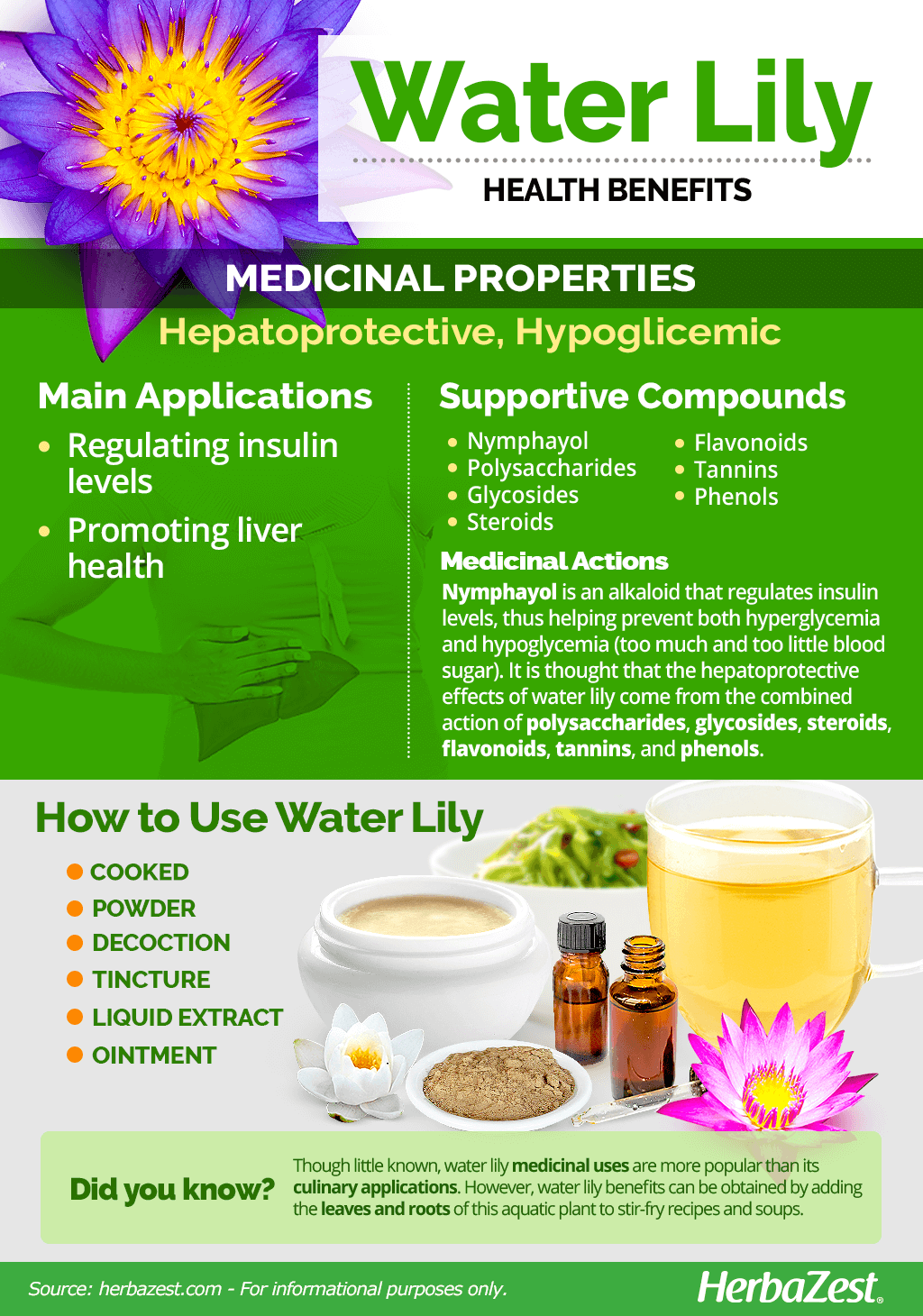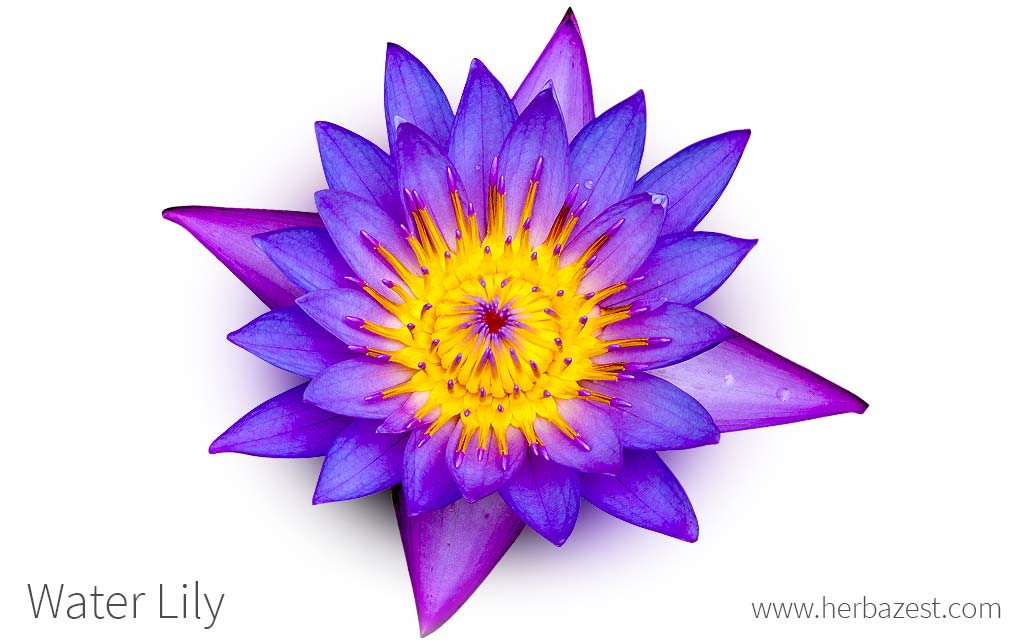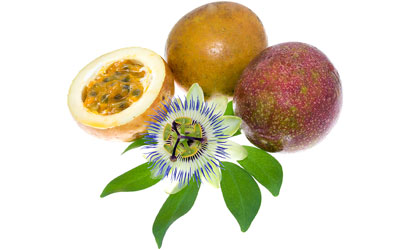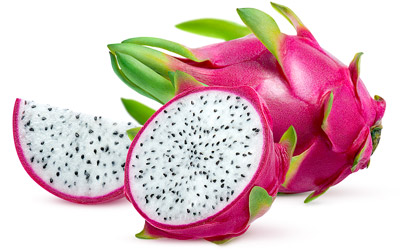Water lily may be best known as the subject of Claude Monet's famous series of paintings, but this flower is much more than just an ornamental addition to a water garden. Water lily has been used throughout history for its medicinal properties, and recent research has just begun to investigate the true value of the water lily.
Water Lily Medicinal Properties
- Medicinal action Hepatoprotective, Hypoglycemic
- Key constituents Nymphayol
- Ways to use Hot infusions/tisanes, Liquid extracts, Tincture, Powder, Ointment
- Medicinal rating (2) Minorly useful plant
- Safety ranking Safety undetermined
Health Benefits of Water Lily
Water lily health benefits have not been extensively researched, however several studies have suggested potential medicinal uses for this aquatic plant, such as:
Regulating insulin levels. Water lily extracts have been shown to keep the levels of insulin in the body stable, preventing blood sugar fluctuations.
Promoting liver health. Water lily has been shown to prevent potential liver damage, also promoting the regeneration of this important organ.
Water lily properties have been compared with those of hydrocortisone, as the plant has been suggested equally useful for relieving pain caused by swelling.
How It Works
A compound called nymphayol is thought to be behind most water lily health benefits. This alkaloid compound works to regulate insulin levels in the blood, thus helping prevent both hyperglycemia and hypoglycemia (too much and too little blood sugar), which leads to steadier body functions and may help in the the treatment and prevention of diabetes and other metabolic disorders.
The compounds responsible for water lily's hepatoprotective properties have not yet been identified, but researchers are studying the effects of other chemical substances in this aquatic species, such as alkaloids, polysaccharides, glycosides, steroids, flavonoids, tannins, and phenols.
Other herbs that promote liver health are chicory, dandelion, and milk thistle, whereas cinnamon, goldenberry, and yacon have hypoglycemic effects.
Water Lily Side Effects
Because not many studies have been done on water lily, it is unknown whether the plant has many side effects. Historical documents claim that it may influence the central nervous system (CNS), producing hallucinogenic and narcotic effects, but this claim has not been corroborated by research.
Water Lily Cautions
Modern research has not indicated any medical interactions, but based on historical record, water lily supplements should not be used by those who are taking pain relievers - such as opioids - antidepressants, antipsychotics, or medications used to treat dementia, Alzheimer's disease, or Parkinson's disease. The plant should also be avoided by those with disorders relating to the central nervous system, including seizure disorders and psychological disorders. Additionally, because of the lack of research about the plant, those who are pregnant or breastfeeding should not take water lily.

How to Consume Water Lily
- Edible parts Flowers, Leaves, Root
Water lily is not often regarded as an edible plant, but it actually can be consumed in both culinary and medicinal preparations.
Natural Forms
Cooked. The roots, leaves, and unopened buds of water lily are not commonly eaten alone or used as culinary ingredients. However, water lily health benefits can be be obtained by adding the herb to stir-fry recipes and soups.
Powder. Water lily powder is often taken by being mixed into a drink or other food, and it is most useful for regulating blood sugar and protecting the liver.
Decoction. When taken in this form water lily is beneficial for stabilizing blood sugar and protecting the liver. A decoction can be made by boiling one ounce (30 g) of powdered root in 10 ounces (300 mL) of water for 30 minutes, and is usually taken three times per day.
Water lily medicinal uses, though rare, are more popular than its culinary applications.
Herbal Remedies & Supplements
Tincture. Take up to 10 drops of tincture a day to normalize insulin levels or to prevent liver damage.
Extract. Up to one teaspoon of water lily extract can be taken internally to regulate blood sugar, or it can be applied externally to help reduce pain and swelling.
Ointment. Applied externally, ointment made from water lily can relieve inflammation and pain.

Buying
- Where to buy Big online retailers, Specialized health stores, Online herb stores, Local herbal store, Online health stores
Natural Forms
Water lily is popular among gardeners, so seeds or cuttings are often available at gardening centers worldwide. Depending on the location and climate, some stores may have only hardy or only tropical varieties available.
Other natural forms of water lily for medicinal consumption, such as the powdered bulbs, are more likely to be found online.
Herbal remedies & Supplements
Medicinal preparations of water lily are not always easily found, but they may be available in certain herbal shops or specialized health stores, as well as through online retailers.
Growing
- Life cycle Perennial
- Harvested parts Roots, Rhizome
- Light requirements Full sun, Partial shade
- Soil Clay loam, Flooded
- Soil pH 6.6 – 7.3 (Neutral)
- Growing habitat Everywhere except tundra
- Planting time Early spring, Spring
- Plant spacing average 0.3 m (0.98 ft)
- Propagation techniques Cuttings
- Potential insect pests Aphids, Beetles, Moths, Leafminers
- Potential diseases Crown rot, Fungi
Water lily is a popular plant for those looking to start a water garden. Growing water lilies can require a little extra care because they are grown in water instead of on land, but their beautiful blooms are worth the extra effort.
Growing Guidelines
Water lilies can be propagated either by seeds or by cuttings, generally rhizomes.
To plant in a pond, the water lily seeds or rhizomes should be placed in a 10 - 16 inch (25 - 40 cm) pot. Do not cover the top of the rhizome with soil. The pot should be set in a pond with a water depth of 6 - 12 inches (15 - 30 cm).
Water lilies should be planted in a heavy garden soil, such as clay or loamy soil. Add a layer of rocks or sand on top to help keep the soil in place.
A place with full sun to partial shade is ideal for water lilies.
Hardy water lilies should be planted in early spring, when the water temperature is approximately 50°F (10°C), whereas tropical water lilies should be planted later, once the water reaches 70°F (21°C).
Both hardy and tropical lilies will bloom from late spring to early fall.
Hardy water lilies can survive the winter outdoors in deep enough water by becoming dormant. If the water is shallow, they should be brought inside stored in a cool, moist environment below 50°F (10°C).
Tropical water lilies cannot survive winters in cold climates, so should be brought indoors and kept in water at a temperature of 68°F (20°C).
Fertilizer tablets may be used up to once a month in spring and early summer, but it is not advised to over-fertilize, as this will increase amounts of algae in the water.
Although few pests are attracted to water lilies, the plants may be damaged by aphids, midges, and moths.
Some water lilies are susceptible to fungus, but resistant varieties are widely available.
Additional Information
- Other uses Cosmetics
Plant Biology
Water lily is a perennial aquatic plant. Some varieties of water lily can grow up to 12 feet (3.6 m) across, but most only reach about six feet (1.8 m). The plant's roots anchor it in the pond's soil, and stems connect the roots to the leaves and flowers that float on the surface. Blooms can show a variety of colors, depending on the type of water lily, but the flowers are usually red, pink, or purple. Many water lily blooms open in the morning and close at night, although some varieties will open at night and close in the morning.
Classification
Water lilies all fall under the genus Nymphaea, in the family Nymphaeaceae. This family is made up of over 70 species, and over 30 of those species are types of water lily. All other plants in the family are also aquatic flowers.
Varieties and Subspecies of Water Lily
There are several different species of water lily. One of the most common is the white water lily (Nimphaea alba). This one is also commonly used in medicinal preparations, as is the fragrant water lily (Nimphaea odorata).
Water lilies are commonly confused with lotuses because several plants within Nymphaea are colloquially referred to as lotuses. However, true lotuses actually belong to the Nelumbonaceae family, while all water lilies are under the Nymphaea genus, which belongs to the Nymphaeaceae family.
Historical Information
Water lilies are thought to be some of the oldest aquatic plants alive. They were often used in art in ancient Egypt, and were known to the ancient Greeks as well. They became popular components of European water gardens and are most famously represented in Claude Monet's paintings.
The name of water lily's family, Nymphaea, has a Greek origin, meaning "nymph". In Greek mytology, nymphs were supernatural beings associated with water (later known as water sprites or water fairies).
Economic Data
Although the water lily is a common garden plant, it is not an economically-important crop, so little economic data about the plant exists. Aside from seeds and cuttings sold in garden centers, the plant is most commonly used as an ingredient in cosmetics.
Popular Beliefs
In ancient Egypt, water lily was considered sacred. Its blooms, which opened in the morning and closed at night, were associated with the rising and setting of the sun as well as the life cycle of death and rebirth. For this reason, it was used in funeral ceremonies.
Other Uses
Gardening. The most popular use for water lily is as an ornamental in garden ponds.
Cosmetic industry. Water lilies are occasionally used in personal care products, as they can reduce redness and swelling in the skin and are thought to contain beneficial vitamins.
Water lily is both a beautiful and useful plant to grow in any garden. Its ability to control insulin, protect the liver, and reduce swelling make it a valuable herbal remedy.
Sources
- International Journal of Biomedical Research, Evaluation of Hepatoprotective activity of Ethanolic Extract of Nymphaea alba Linn Flower in experimental rats, 2013
- Journal of Advanced Pharmaceutical Technology and Research, A comprehensive review on Nymphaea stellata: A traditionally used bitter, 2010
- Journal of Experimental Botany, Symbolism of plants: examples from European-Mediterranean culture presented with biology and history of art: JULY: Lotus, 2009
- Nymphaeaceae Family, p. 33
- Pinnacle Health, White water lily (Nymphaea odorata)
- University of Illinois, Water Gardening, Planting Aquatic Plants
- Zen & the Art of Pond Building, pp. 107-108






